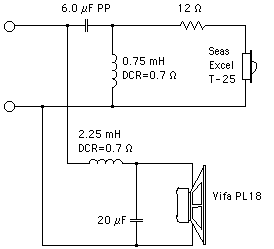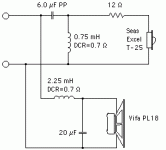Ok bare with me here. I had a cerebral aneurysm about ten years ago. I'm a miracle child to still be alive. I work in an engineering capacity, but lately my brain has been slowing down. Maybe that and old age too.
Designing a cross over, tweeter is X db SPL above the woofer, so I have to knock it down a bit. Using a crossover calc where it asks for impedance, do I need to add the resistive factor in there. So say I need a 3.6 ohm resistor to level it out, instead of 6 ohm for the calc should I be using 9.6?
Designing a cross over, tweeter is X db SPL above the woofer, so I have to knock it down a bit. Using a crossover calc where it asks for impedance, do I need to add the resistive factor in there. So say I need a 3.6 ohm resistor to level it out, instead of 6 ohm for the calc should I be using 9.6?
So say I need a 3.6 ohm resistor to level it out, instead of 6 ohm for the calc should I be using 9.6?
Yes, the series resistor affects the crossover frequency same as the tweeter impedance.
Basically yes, but not entirely. The sum of a resistance and a reactive impedance is not the sum of the two magnitudes, but in this case it is close. It is actually the vector sum, considering the phase of the impedance.
Variations in the impedance are also going to affect the amount of attenuation so that they impose themselves on the shape of the response. This may or may not be a problem in the end. You might have a look at an L-pad.
Variations in the impedance are also going to affect the amount of attenuation so that they impose themselves on the shape of the response. This may or may not be a problem in the end. You might have a look at an L-pad.
Do you only want to attenuate the tweeter SPL, or do you also want to increase the minimum impedance seen by the amplifier?
An L-pad voltage divider circuit will attenuate a speaker with only minor effects to the tweeter impedance. L-pads keep the load on the amplifier constant, affecting only the power delivered to the speaker. The power delivered by the amplifier remains constant. Since L-pads are made from resistors, it does not induce any phase shifts or affect frequency response. L-Pad calculators generate two resistor values which (1) maintain the impedance of the tweeter such that the crossover component values do not need to change, and (2) reduce the resonant peak impedance because of the current path the of L-pad resistor connected to ground.
If you also need to MODESTLY increase the minimum tweeter inpedance for amplifier safety, you can add/connect the necessary small series resistor between the amplifier output and the tweeter crossover....a crossover circuit which might also include an L-pad to obtain the desired SPL.
Google
L-pad speaker
L-pad calculator
An L-pad voltage divider circuit will attenuate a speaker with only minor effects to the tweeter impedance. L-pads keep the load on the amplifier constant, affecting only the power delivered to the speaker. The power delivered by the amplifier remains constant. Since L-pads are made from resistors, it does not induce any phase shifts or affect frequency response. L-Pad calculators generate two resistor values which (1) maintain the impedance of the tweeter such that the crossover component values do not need to change, and (2) reduce the resonant peak impedance because of the current path the of L-pad resistor connected to ground.
If you also need to MODESTLY increase the minimum tweeter inpedance for amplifier safety, you can add/connect the necessary small series resistor between the amplifier output and the tweeter crossover....a crossover circuit which might also include an L-pad to obtain the desired SPL.
L-pad speaker
L-pad calculator
Kimon, it will certainly change the summation at the crossover frequency for the tweeter as you will be changing the load seen by the C/L filter for the tweeter. It may produce a dip (or a peak ?) at the crossover frequency. You would have to use 'X sim' to simulate such a change.
C.M
C.M
In the case of 2nd order and higher crossovers, changing the load impedance doesn't so much change the crossover frequency as much as it changes the Q (alignment) of the filter.
For everything discussed this thread I'd recommend to sim it using a speaker crossover simulator like XSim. A series resistor can work well in some situations, and an L-pad work better in others.
For everything discussed this thread I'd recommend to sim it using a speaker crossover simulator like XSim. A series resistor can work well in some situations, and an L-pad work better in others.
Thanks folks. I've built speakers for a long time just never dove off into the passive cross overs deep enough to build my own and was wondering out loud. I have the newest version of Soundeasy, funny I had an older version for years, just never dove off into all it can do. In the past for cost I have always bought the preassembled crossovers and added a few resistors or built a fixed L-pad. Always in a rush to hear them.
This new set I can take my time and plan on using all I can to get them the best possible sound. Even a little fancier cabinets, take my veneer skills to a new level...
Wish there was a section on this board dedicated to Soundeasy, I'm sure I would have lots of questions...already have a few.... Thanks
This new set I can take my time and plan on using all I can to get them the best possible sound. Even a little fancier cabinets, take my veneer skills to a new level...
Wish there was a section on this board dedicated to Soundeasy, I'm sure I would have lots of questions...already have a few.... Thanks
- Status
- This old topic is closed. If you want to reopen this topic, contact a moderator using the "Report Post" button.
- Home
- Loudspeakers
- Multi-Way
- Crossover resistance

